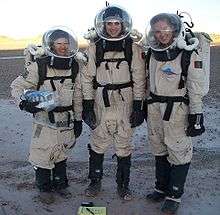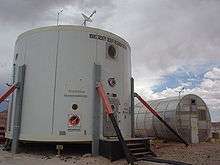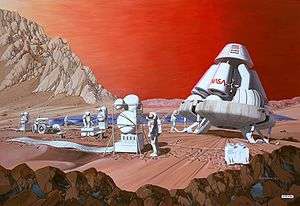Mars Desert Research Station
The Mars Desert Research Station (MDRS) is the second simulated Mars analog habitat owned and operated by the Mars Society.

The station was built near Hanksville, Utah, in the western United States in the early 2000s, and it is typically manned by small crews who visit the station for one week to three month rotations to conduct scientific research.[1]
The campus includes a two-story habitat (the Hab), a greenhouse (the GreenHab), a solar observatory (the Musk Observatory), a robotic observatory, an engineering pod (the RAM) and a science building (the ScienceDome). Tunnels between all of the buildings except the robotic observatory allow crews to travel between the buildings without a spacesuit while they are in simulation (sim).
Background
The MDRS station is situated on the San Rafael Swell of southern Utah,[2] located 11.63 kilometres (7.23 mi) by road northwest of Hanksville, Utah.[3] It is the second such analogue research station to be built by the Mars Society, following in the footsteps of the Flashline Mars Arctic Research Station or FMARS[4] on Devon Island in Canada's high Arctic.
The third station, the European Mars Analog Research Station or EuroMARS was founded and built in early 2002. It was shipped to the UK in the mid 2000s in preparation for deployment to the selected research site (approximately N65° 46' 7.18" W16° 45' 30.50") which is located next to the Krafla Rift Volcano, about 15 kilometres (9.3 mi) north east of the village of Myvatn, Iceland.[5]
The fourth station, the Australia Mars Analog Research Station / MARS Oz is currently in the planning stages and it will be deployed to the selected research site (S 30° 18' 13.91" E 139° 26' 39.55") east of the Arkaroola Sanctuary, which itself is roughly 521 kilometres (324 mi) north of Adelaide, South Australia.[6]
The Mars Society launched the Mars Analog Research Station (MARS) Project in order to develop key knowledge needed to prepare for the human exploration of Mars.[7] The project's goals are to develop field tactics based on environmental constraints (i.e., being required to work in spacesuits), to test habitat design features and tools, and to assess crew selection protocols.[8] Although much warmer than Mars, the desert location was selected because of its Mars-like terrain and appearance.
From the moment they arrive at MDRS, crews enter a "living on Mars" simulation. Crew members must wear an analogue space suit simulator or a "sim suit" when completing tasks outside the Habitat (HAB) to simulate the protection they would need from the harsh Martian environment. Complete analogue space suit simulators include a helmet, jumpsuit, boots, gaithers, gloves, an air supply pack, Platypus water pack, and a radio. Hand held radios mounted on the suits' helmets (with externally mounted push to talk switches) are used to communicate with Habitat communication base (Hab-com) and with fellow analogue Mars surface explorers on the same EVA. For safety reasons, there is always one crew member in the HAB to act as Hab-Com in case anything goes wrong on the extra-vehicular activity (EVA). In the event that crew's vehicles break down or one of their members becomes injured in the field, being able to communicate with the HAB is crucial to protect the safety of the people partaking in the analogue Mars surface exploration simulation mission.
Destinations for EVAs can be chosen from an established waypoint database and traveled to either on foot or by ATV.
MDRS is owned and operated by The Mars Society, which selects the crews and handles most of the administrative tasks. The Mars Society is an international, non-profit organization, with chapters worldwide, that is dedicated to convincing governments and the public of the benefits of Mars exploration through various projects such as M.A.R.S., the Mars Analogue Pressurized Rover Competition, and the ARCHIMEDES Mars balloon mission.
Students interested in participating in the project receive a $500 travel stipend from the Spaceward Bound Program run out of NASA Ames Research Center.[9] The Spaceward Bound Program aims to train the next generation of space explorers by allowing students and teachers to participate in projects in extreme environments that can serve as simulations for the moon or Mars.
A Local Manager has been hired to take care of some of the maintenance and support services.
Research
Each crew establishes different scientific goals they hope to accomplish during their time at MDRS. The majority of the biological studies carried out involve extremophiles, or organisms that are capable of living in extreme environments. Bacteria and algae isolated from the surrounding desert are common subjects of study. These microorganisms have been studied for their DNA, diversity and the environments they live in. For example, in a study for methanogens researchers studied soil and vapour samples from five different desert environments in Utah, Idaho and California in the United States, and in Canada and Chile. Of these, five soil samples and three vapour samples from the vicinity of the MDRS were found to have signs of viable methanogens.[10][11]
A unique opportunity to combine geology and biology occurs when studying the endoliths found in rocks around the Hab. These species of bacteria are capable of living inside rocks and obtaining the energy they need by photosynthesizing using the light that penetrates the rocks. These extreme organisms are a popular subject of research at MDRS for both geologists and biologists.[12]
Other experiments include a study of the effect of EVAs on the heart rates and blood pressures of crew members, a human factors study that examine the correlation between cognitive ability and mood and a study on how much a space suit inhibits dexterity in comparison to regular street clothes.
Crews

MDRS crews traditionally consist of six people, who volunteer for one of the two-week shifts or crew rotations available during the northern hemisphere's winter months. The field season ends in the northern spring since the summer heat of the desert is not conducive to a pleasant simulation. Crews pay all of their own transportation expenses to get to and from the designated assembly place from where they are transported to and from MDRS. As Volunteers, the Crews are not paid for their participation in a crew rotation at the station, but do get valuable experience. The crews usually consist of a mix of Scientist, astronomers, physicists, biologists, geologists, engineers and the occasional journalist. Each crew member is usually assigned a role: Commander, Executive Officer (ExO), Health and Safety Officer (HSO), Crew Biologist, Crew Geologist or Chief Engineer.
The Crew Commander is ultimately responsible for the entire crew and operations. Their other responsibilities include maintaining a structured stream of information from the crew to Mission Support, establishing the agenda for each day (EVAs, maintenance, cooking, cleaning, etc.) and holding morning and evening meetings with all crew members. The Executive Officer's duty is to act as the second in command during the mission and to act as the Commander in the event that the Commander is incapacitated or unavailable. The Crew Geologist and the Crew Biologist work together to establish and accomplish the science goals of the mission. The Crew Geologist and Crew Biologist are in charge of developing the geology and biology goals for the mission, planning field EVAs and subsequent laboratory work to achieve those goals. Both the Crew Geologist and Crew Biologist work with the Remote Science Team (RST) during all stages of the mission. The Chief Engineer is responsible for maintaining all systems necessary for routine Hab operations. These include the power, water, ATV and GreenHab systems.[13]
As of February 2017, 175 crews have served rotations at MDRS over a period of sixteen years.[14]
The Research Station


The research station consists of three buildings, the Habitat, the Greenhab, the Musk Mars Desert Observatory and a remotely located Engineering Support Equipment Area.
Habitat
The analogue Mars Lander Habitat, commonly referred to as "The HAB", is a two-story cylinder that measures about 10 metres (33 ft) in diameter and is a crew's combined home and place of work during a Mars surface exploration simulation. On the first floor there are two simulated airlocks, a shower and toilet, an EVA Preparation room for storage and maintenance of the simulated space suits and their associated equipment, and a combined science lab and engineering work area. The laboratory is shared between the Crew Geologist and the Crew Biologist and includes an autoclave, analytical balance, microscope, and a stock of chemicals and reagents for conducting biochemical tests. On the second floor are six very small private crew staterooms with bunks and a small reading desk, a common dining and entertainment area, a dedicated communications station and a galley or kitchen equipped with a gas stove, refrigerator, microwave, oven and a sink for meal preparations. Above the six crew staterooms is a Loft which contains the internal fresh water storage tank and equipment storage space. At the peak of the HAB's dome shaped roof is an access hatch to permit maintenance access to the satellite antenna and weather monitoring instruments.
Power is supplied by 12 rechargeable 24-volt batteries, located under the HAB which can provide electrical power for up to twelve hours. In addition to the batteries are two 5 kilowatts (6.7 hp) electricity generators named respectively "Casper" and "Wendy". Power from the generators is channeled through a Xantrex inverter, which sends the power either to the battery banks to recharge them or via a panel with 19 circuit breakers, to the HAB electrical distribution system.
Water is supplied to the HAB via a potable water tank located 100 feet (30 m) away in the Engineering Support Equipment Area. The tank is a plastic storage container with a 450-U.S.-gallon (1,700 L; 370 imp gal) capacity (8 days worth of water at 6 U.S. gallons (23 L; 5.0 imp gal) per person per day). Water must be manually carried or pumped via a hose from the potable water tank to the HAB's internal tank, which holds about 60 U.S. gallons (230 L; 50 imp gal). The water is then gravity fed into a pressure pump that distributes the fresh water to the rest of the HAB, including a water heater. The water used to flush toilet is greywater. This is waste water that has run down the sink and shower drains in the HAB and then through the greywater system out of the GreenHab. Water is rationed and monitored to minimize inefficiency and waste in the system.
The HAB is also equipped with an internet connection and several web cams so that the public can view the ongoing mission.[15]
GreenHab
The GreenHab is a greenhouse used for growing crops and plant research. The original Gary Fisher GreenHab, retrofitted in 2009 from a closed loop water recycling center to a functional greenhouse, was destroyed by fire in December 2014,[16] and replaced in September 2015 after an Indiegogo campaign raised $12,540 to rebuild it.
Originally the rebuilt GreenHab was planned as a geodesic dome. However, once the pad and frame were in place, there appeared to be no way to make it wind and winter tight, so it was completed as the new ScienceDome. The new Greenhab is a 12 foot by 24 foot transparent building that is climate and light controlled. The plants grown in the Greenhab are mostly herbs, greens, radishes, tomatoes, and other vegetables.
Musk Mars Desert Observatory

The Musk Mars Desert Observatory houses a 28-centimetre (11 in) Schmidt-Cassegrain telescope, donated by Celestron. The telescope is capable of being operated remotely, and is accessible to amateur and professional astronomers via the internet. The observatory's other sponsors include Le Sueur Manufacturing Inc., which provided the Astro-Pier on which the telescope is mounted; Software Bisque, which provided TheSky software; Vince Lanzetta of East Coast Observatories; Adirondack Video Astronomy; High Point Scientific; Technical Innovations; and the Lehigh Valley Amateur Astronomical Association.
The addition of the Musk Mars Desert Observatory provides research opportunities that were not available before, not only to the crew, but local teachers and students. It also encourages more public involvement as students and teachers are invited to interact with the crew and to use the observatory as a learning tool.
Engineering tasks are completed in the RAM (Repair and assembly module) a retrofitted Chinook helicopter fuel compartment designed with for tool storage, and work spaces for engineering project and repair of station instruments. It was moved to the campus in October 2017 and became fully operational in November 2018.
Other
North of the GreenHAB is the underground septic tank and its outflow field. This area is a "No Drive - Foot Traffic Only Zone" as there is no record of where exactly the septic tank is buried. East of the GreenHab is an omnidirectional Jovian radio telescope.
The MDRS is the site of the University Rover Challenge,[17] the first of which was held on June 2, 2007.
The Flag of Mars appears on a couple of the buildings, as does the Flag of the United States. The Mars Society logo is also present in a few places.
See also
- Flashline Mars Arctic Research Station
- BYU Mars Rover
- Colonization of Mars
- Exploration of Mars
- Flag of Mars
- Haughton-Mars Project
- Life on Mars
- Manned mission to Mars
- MARS-500
- Mars Desert Research Station
- Mars Direct
- Mars to Stay
- Moon Society
- Space colonization
- Space science
- Timekeeping on Mars
References
- "Meet the Crews Preparing for Human Life on Mars". 2018-05-04. Retrieved 2018-10-16.
- Horton, Michael (January 18, 2009). "Mars Desert Research Station Simulates Mars Like Base". TechFragments.com. Archived from the original on February 5, 2010. Retrieved February 16, 2010.
- Gregory, Hugh; Graham, Paul (March 2007). "wp20070331.xls". MDRS-Navigation-Waypoints-Data-Base.
- "FMARS Location". fmars.marssociety.org. Archived from the original on June 23, 2011. Retrieved February 21, 2011.
- "EuroMars". european-mars-analog-research-station.co.tv/. Retrieved February 21, 2011.
- "OzMars" (PDF). 8th AMEC Conf Proceedings Pages 17-18. Archived from the original (PDF) on February 18, 2011. Retrieved February 21, 2011.
- "Mars Desert Research Station: Project Background". MarsSociety.org. Retrieved February 16, 2010.
- Kaku, Michio (2018). The Future of Humanity: Terraforming Mars, Interstellar Travel, Immortality, and Our Destiny Beyond Earth. Doubleday, a division of Penguin Random House. p. 85. ISBN 9780385542760.
The organizers of the MDRS try to make the experience as realistic as possible and use these sessions as a way to test the psychological dimension of being isolated on Mars for extended periods with relative strangers.
- Conrad, Linda (November 2007). "Spaceward Bound!". NASA.gov. Archived from the original on February 16, 2010. Retrieved February 16, 2010.
- Moran, Mark; Miller, Joseph D; Kral, Tim; Scott, Dave (November 2005). "Desert methane: Implications for life detection on Mars". Icarus. 178 (1): 277–280. Bibcode:2005Icar..178..277M. doi:10.1016/j.icarus.2005.06.008.
- Young, Kelly; Chandler, David L (December 7, 2005). "Extreme bugs back idea of life on Mars". New Scientist.
- "Research Summaries". MarsSociety.org. Retrieved February 16, 2010.
- "MDRS Mission Rules". mdrs.marssociety.org. Archived from the original on July 10, 2012. Retrieved February 21, 2011.
- "MDRS 2011". MDRS2011.com. Archived from the original on March 19, 2011. Retrieved February 21, 2011.
- "MDRS Web Cams". FreeMars.org. Retrieved February 21, 2011.
- "MDRS GreenHab Destroyed by Fire". Mars Society. 30 December 2014. Archived from the original on 6 February 2015. Retrieved 31 December 2014.
- "University Rover Challenge". urc.marssociety.org. Retrieved February 21, 2011.
External links
| Wikimedia Commons has media related to Mars Desert Research Station. |
